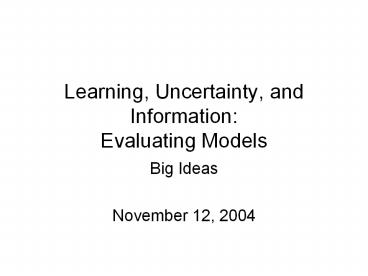Learning, Uncertainty, and Information: Evaluating Models - PowerPoint PPT Presentation
1 / 20
Title:
Learning, Uncertainty, and Information: Evaluating Models
Description:
Learning, Uncertainty, and Information: Evaluating Models Big Ideas November 12, 2004 Roadmap Noisy-channel model: Redux Hidden Markov Models The Model Decoding the ... – PowerPoint PPT presentation
Number of Views:92
Avg rating:3.0/5.0
Title: Learning, Uncertainty, and Information: Evaluating Models
1
Learning, Uncertainty, and InformationEvaluating
Models
- Big Ideas
- November 12, 2004
2
Roadmap
- Noisy-channel model Redux
- Hidden Markov Models
- The Model
- Decoding the best sequence
- Training the model (EM)
- N-gram models Modeling sequences
- Shannon, Information Theory, and Perplexity
- Conclusion
3
Re-estimating
- Estimate transitions from i-gtj
- Estimate observations in i
- Estimate initial i
4
Roadmap
- n-gram models
- Motivation
- Basic n-grams
- Markov assumptions
- Evaluating the model
- Entropy and Perplexity
5
Information Communication
- Shannon (1948)
- Perspective
- Message selected from possible messages
- Number (or function of ) of messages measure of
information produced by selecting that message - Logarithmic measure
- Base 2 of bits
6
Probabilistic Language Generation
- Coin-flipping models
- A sentence is generated by a randomized algorithm
- The generator can be in one of several states
- Flip coins to choose the next state.
- Flip other coins to decide which letter or word
to output
7
Shannons Generated Language
- 1. Zero-order approximation
- XFOML RXKXRJFFUJ ZLPWCFWKCYJ FFJEYVKCQSGHYD
QPAAMKBZAACIBZLHJQD - 2. First-order approximation
- OCRO HLI RGWR NWIELWIS EU LL NBNESEBYA TH EEI
ALHENHTTPA OOBTTVA NAH RBL - 3. Second-order approximation
- ON IE ANTSOUTINYS ARE T INCTORE ST BE S DEAMY
ACHIND ILONASIVE TUCOOWE AT TEASONARE FUSO TIZIN
ANDY TOBE SEACE CTISBE
8
Shannons Word Models
- 1. First-order approximation
- REPRESENTING AND SPEEDILY IS AN GOOD APT OR COME
CAN DIFFERENT NATURAL HERE HE THE A IN CAME THE
TO OF TO EXPERT GRAY COME TO FURNISHES THE LINE
MESSAGE HAD BE THESE - 2. Second-order approximation
- THE HEAD AND IN FRONTAL ATTACK ON AN ENGLISH
WRITER THAT THE CHARACTER OF THIS POINT IS
THEREFORE ANOTHER METHOD FOR THE LETTERS THAT THE
TIME OF WHO EVER TOLD THE PROBLEM FOR AN
UNEXPECTED
9
N-grams
- Perspective
- Some sequences (words/chars/events) are more
likely than others - Given sequence, can guess most likely next
- Provides prior P(W) for noisy channel
- Used in
- Speech recognition
- Bioinformatics
- Information retrieval
10
Basic N-grams
- Estimate probabilities by counts in large
collections - Most trivial 1/tokens too simple!
- Standard unigram frequency
- word occurrences/total corpus size
- E.g. the0.07 rabbit 0.00001
- Too simple no context!
- Conditional probabilities of word sequences
11
Markov Assumptions
- Exact computation requires too much data
- Approximate probability given all prior wds
- Assume finite history
- Bigram Probability of word given 1 previous
- First-order Markov
- Trigram Probability of word given 2 previous
- N-gram approximation
Bigram sequence
12
Issues
- Relative frequency
- Typically compute count of sequence
- Divide by prefix
- Corpus sensitivity
- Shakespeare vs Wall Street Journal
- Very unnatural
- Ngrams
- Unigram little bigrams colloc trigramsphrase
13
Toward an Information Measure
- Knowledge event probabilities available
- Desirable characteristics H(p1,p2,,pn)
- Continuous in pi
- If pi equally likely, monotonic increasing in n
- If equally likely, more choice w/more elements
- If broken into successive choices, weighted sum
- Entropy H(X) X is a random var, p prob fn
14
Measuring Entropy
- If split m objects into 2 bins size m1 m2, what
is the entropy?
If m1m2, 1 If m1/m 1 or m2/m 1, 0 Satisfies
criteria
15
Evaluating models
- Entropy Perplexity
- Information theoretic measures
- Measures information in model or fit to data
- Conceptually, lower bound on bits to encode
- E.g. 8 things number as code gt 3 bits/trans
- Alt. short code if high probability longer if
lower - Can reduce average message length
- Perplexity
- Weighted average of number of choices
- Branching factor
16
Computing Entropy
- Picking horses (Cover and Thomas)
- Send message identify horse - 1 of 8
- If all horses equally likely, p(i) 1/8
- Some horses more likely
- 1 ½ 2 ¼ 3 1/8 4 1/16 5,6,7,8 1/64
17
Entropy of a Sequence
- Basic sequence
- Entropy of language infinite lengths
- Assume stationary ergodic
18
Cross-Entropy
- Comparing models
- Actual distribution unknown
- Use simplified model to estimate
- Closer match will have lower cross-entropy
19
Perplexity Model Comparison
- Compare models with different history
- Train models
- 38 million words Wall Street Journal
- Compute perplexity on held-out test set
- 1.5 million words (20K unique, smoothed)
- N-gram Order Perplexity
- Unigram 962
- Bigram 170
- Trigram 109
20
Does the model improve?
- Compute probability of data under model
- Compute perplexity
- Relative measure
- Decrease toward optimum?
- Lower than competing model?
Iter 0 1 2 3 4 5 6 9 10
P(data) 9-19 1-16 2-16 3-16 4-16 4-16 4-16 5-16 5-16
Perplex 3.393 2.95 2.88 2.85 2.84 2.83 2.83 2.8272 2.8271
21
Entropy of English
- Shannons experiment
- Subjects guess strings of letters, count guesses
- Entropy of guess seq Entropy of letter seq
- 1.3 bits Restricted text
- Build stochastic model on text compute
- Brown computed trigram model on varied corpus
- Compute (per-char) entropy of model
- 1.75 bits































